Loading Dysfunctions
Aug 19, 2018
I see more and more fitness and rehab professionals promoting the message of 'don't load a dysfunction' and it annoys the hell out of me. This displays a complete lack of understanding of the complexities of human movement, the multifactorial nature of injuries and pain, and the many uncertainties of rehab and recovery. Not to mention that no one can tell you what the hell a dysfunction actually is.

This message also has some negative and possibly harmful ramifications for those who love to exercise but even more annoyingly creates unnecessary barriers and restrictions for those who don't like to exercise. So I want to spend the next 5 minutes discussing why I think many of these influential, well-known, and highly respected fitness and rehab professionals are wrong, and make a case for why we should be actually loading these so-called 'dysfunctions'.
Loading Dysfunction
So first what is a 'dysfunctional' movement? Despite many claims, we actually have very little evidence that tells us what movements, activities or exercises are bad, dangerous, or harmful for us... if indeed there are any at all.
Many will claim that they can spot a dysfunctional movement or exercise just by looking at it. But the fact is when it comes to observing movement "beauty is in the eye of the beholder" meaning that what can look ugly and problematic for one person, can look perfectly fine to another.
The notion that we can tell what is good or bad movement just by looking at it is frankly nonsense. This overly simplistic and reductionist way of classifying human movement based on an individual's observation alone needs to stop.
To put this as simply and clearly as I can... how we move is dictated by many things such as 1) individual factors; such as age, skeletal morphology, previous experience, current confidence, pain levels and so on. 2) task factors, such as the load, speed, intensity, complexity and so on, and finally, 3) environmental factors such as moving while being observed, or in a competitive situation, or using different equipment etc etc etc.
Therefore how we perform an exercise or any other movement is always going to be influenced by these many other factors, meaning that very often no two people will move the same, and often the same person won't move the same way twice.
The Individual
So when assessing any movement we need to recognise that we are all built differently and come in all different shapes and sizes and so we can not all move the same. Variations in our skeletal structure and geometry such as limb length and joint shape and angulation will influence how we move. For example, femoral length and pelvic geometry hugely affects how an individual squats as shown below (ref, ref).
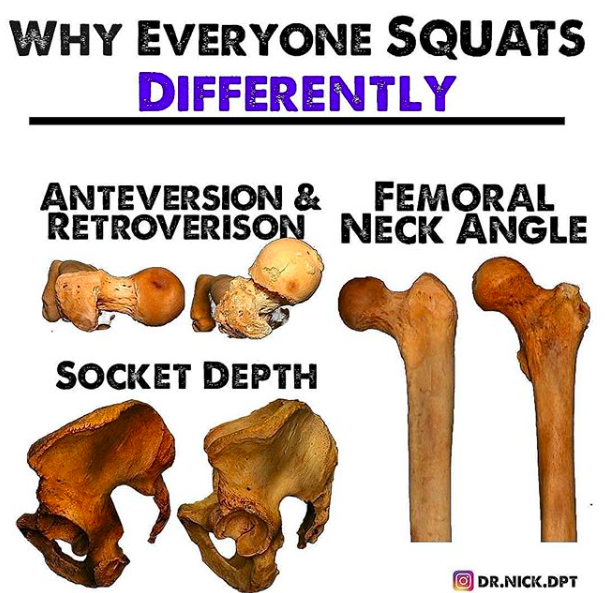
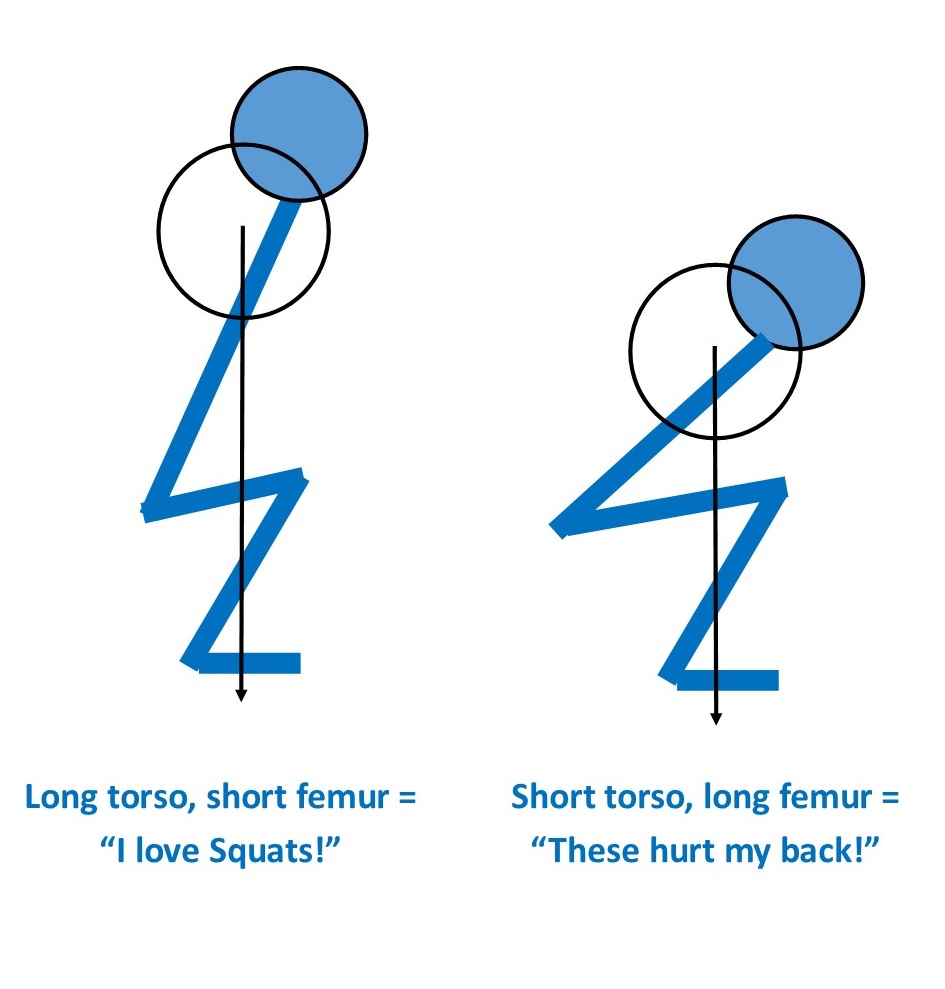
So just because some 'movement specialist' with short femurs, open hip sockets, and a touch of genetic hypermobility can fold up like a deck chair when they squat... don't think you will ever be able to if your bony geometry and genetics are completely different! And just because some 'supple leopard' can reach up between their shoulder blades and scratch the back of their own eyeballs, don't think you will be able to if your shoulder and thoracic bony geometry won't allow it (ref, ref).
It is important to recognise that what may look like 'dysfunctional' movement could be due to very non-modifiable genetic and or skeletal factors. However, this is very difficult to determine clinically without a lot of detailed, expensive, and unnecessary scanning and imaging, but it should always be considered nonetheless.
Now, of course, not all movement restrictions are due to non-modifiable bony factors, many can be due to the more modifiable soft tissue factors. Again determining if a movement restriction is modifiable or not can be difficult, but you can usually begin to realise that you may have some non-modifiable factors limiting your movement if you have tried to work on improving your movement for a few months and nothing has changed.
If this is the case then it may be time to start accepting that your movement isn't going to look like someone else's because of factors outside of your control and try not to get too frustrated or disheartened by your lack of progress in trying to imitate some flexible guru with completely different anatomy.
The Task
Our movements are also hugely affected by the task being done, and again this tends to be ignored by many movement gurus. For example, how an individual bends over to pick up a box of tissues from the floor will be, and should be, completely different from how they bend over to pick up a concrete slab from the floor.
Having someone move the same way regardless of the task's intensity, speed, and purpose is simply batshit crazy, yet its something I see being promoted by many every day. You simply do not need to bend over the same way to do everything, in fact, this is inefficient and not functional.
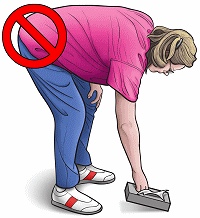

You just do not need to brace your abdominal and pelvic floor muscles or keep your spine in neutral before you reach down to pick something small and light off the floor. Rather than helping and improving movement this can make many people move less and worse as they become overly focused, stressed, worried, and hypervigilant on small, tiny, innocuous things that are just not worth worrying about.
Variation in movement patterns is perversely something a lot of 'movement specialists; understand or feel comfortable with. And movement variation occurs all the time and depending on the task and the load is much more useful than movement restriction (ref, ref).
Now, this is not to say that restricting variations in some movements, in some people, some of the time can be useful because it can. In some situations, in some circumstances, it can be very helpful to coach and constrain movement to help a person move more 'efficiently' during some tasks such as heavy repetitive lifting.
However, do not get fooled into the common belief that applying these movement constraints magically or significantly reduces the risk of injury. Many of our common assumptions about injury risk are being challenged more and more, with many studies in occupational manual handling showing how postural ergonomic and lifting advice doesn't significantly reduce the incidence of back pain as we first thought, and in fact, may even be contributing to it. (ref, ref, ref, ref)
The Environment
Finally, we need to consider the environment as a confounding factor when we assess movement. As therapists and trainers, we often assess people moving in controlled, constrained, and ultimately false environments. Therefore any of the so-called movement dysfunctions we may or may not see here, may or may not occur in other settings or environments. We also need to recognise that just the effect of observing a subject move will affect how they move.
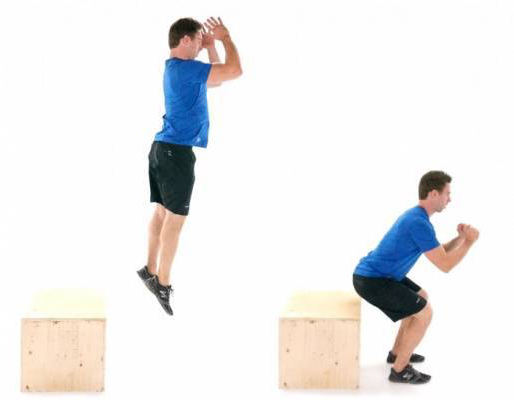
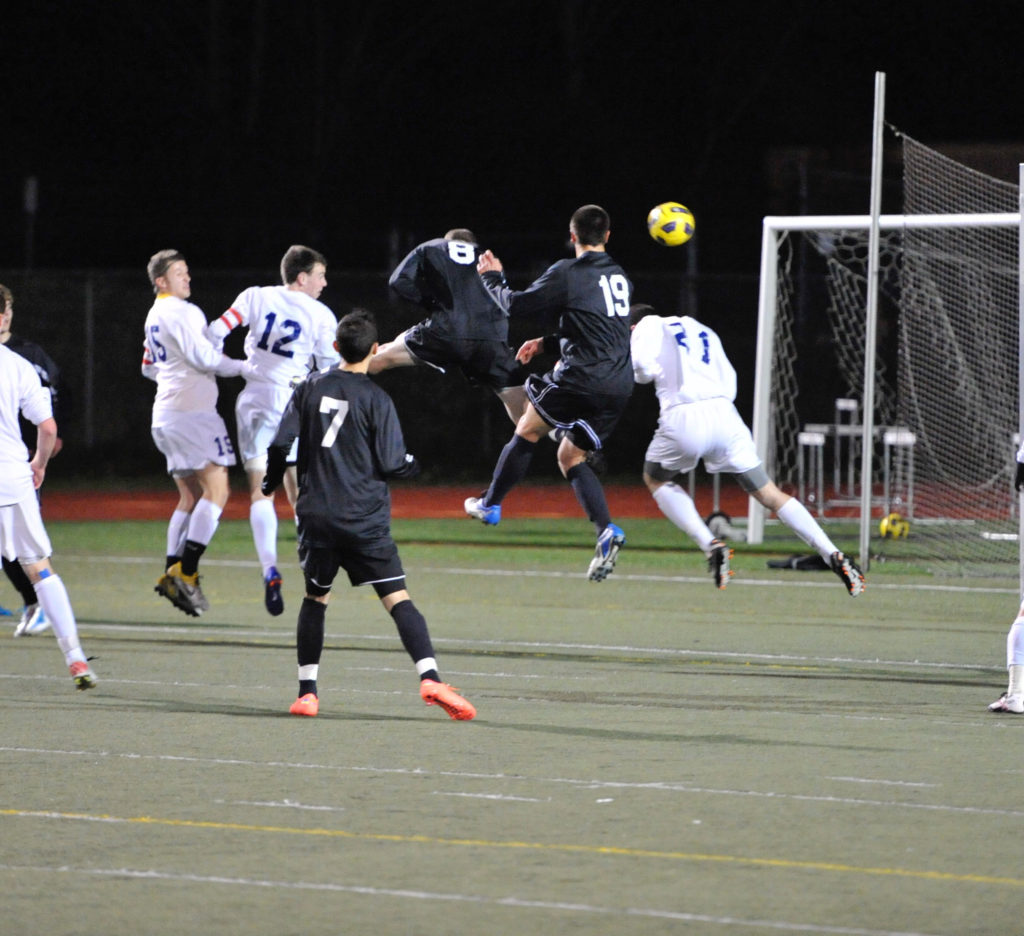
For example, how normally do you think a patient will be moving when being scrutinised in a cubicle, or gym when they are half undressed and feeling a little anxious or nervous? Do you think you will see the same movement strategy will be used when a subject is asked to perform drop landing off a box whilst being observed compared to when they are on a cold wet football pitch on a Tuesday night in Stoke, jumping for a ball whilst dodging an opposing player?
It's not that simple!
So hopefully I have highlighted how all of our movements are based on many variables and what we think may be abnormal or dysfunctional could just in fact be normal and even advantageous variations.
We also need to recognise that the evidence tells us that many of the so-called postural and movement 'dysfunctions' we see in people with pain and disability are often seen in those WITHOUT any pain or disability. Things such as lumbar spine lordosis, thoracic kyphosis, scapula dyskinesis, knee valgus, femoral head CAM deformities, are all seen i people without any pain or pathology.
We also need to recognise that what we think are movement 'dysfunctions' may actually be optimisation strategies in the presence of pain, fear, or a lack of tolerance and capacity. Personally, I think this is one of the most common reasons I see people moving differently or awkwardly.
Why I load 'dysfunctions'
So often it's not the movement that needs to be corrected, it's the pain, fear, lack of capacity or confidence in the movement that does. This is why I load so-called 'dysfunctions'.
I have realised that if I focus more on increasing an individual's capacity and tolerance to so-called 'dysfunctional' movements, they often stop looking as ugly and awkward, and stop feeling as uncomfortable or difficult. When you build a person's comprehensive capacity to move you often find the individual self-organises their movement strategies to become more efficient without you having to do much at all.
This is why I dont use any specific motor control drills or fancy coaching techniques anymore, Instead, I simply give a person the chance to build capacity and confidence in the movement and let their system gradually self-organise and find its most preferred strategy to get the job done. This often makes awkward ugly looking movements look much more efficient and 'pretty'.
However, there have been times when I have also found that the observed 'ugliness' of a movement does not change, but again that also doesn't really matter to me anymore either. As I said at the beginning of this blog 'beauty is in the eye of the beholder' and who am I to say what is an ugly movement or not.
All that I am really concerned about is does this movement feel comfortable and efficient to the person doing it? As far as I am concerned you can have the ugliest-looking movement in the world as long as you are confident, comfortable, and have the capacity, both physically and psychologically to tolerate it!
Summary
So that's my two cents on why I load 'dysfunctional' movements and why I disagree with many of the 'movement specialists' gurus on this topic. Remember that there is little evidence to say what is and what isn't a dysfunctional movement but it's damn well NOT just what it looks like to an observer.
As always thanks for reading
Adam
Stay connected with new blogs and updates!
Join my mailing list to receive the latest blogs and updates.
Don't worry, your information will not be shared.
I hate SPAM, so I promise I will never sell your information to any third party trying to sell you laser guided acupuncture needles or some other BS.

